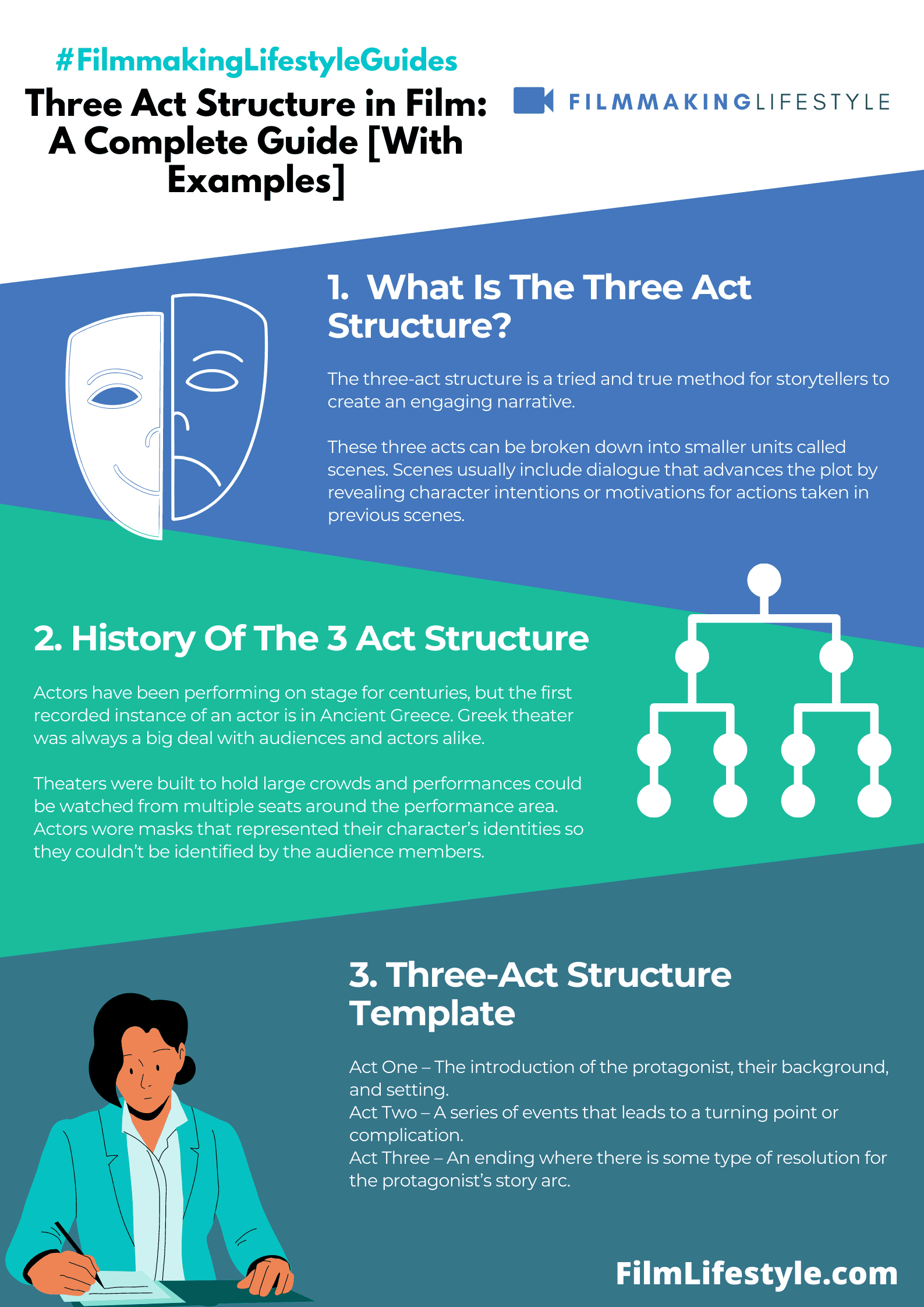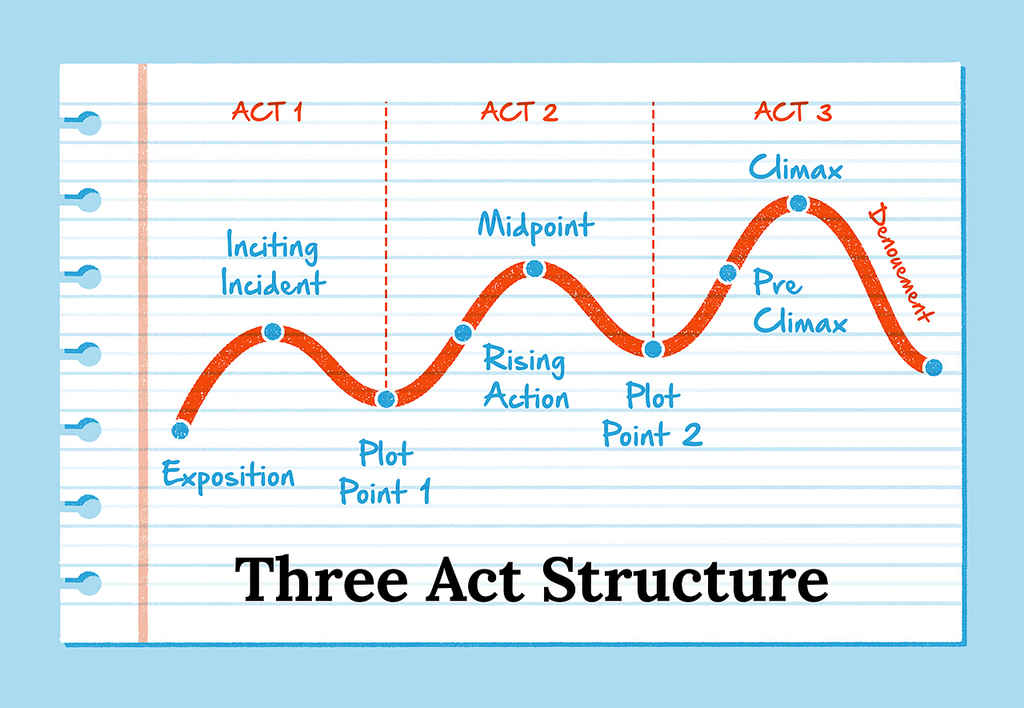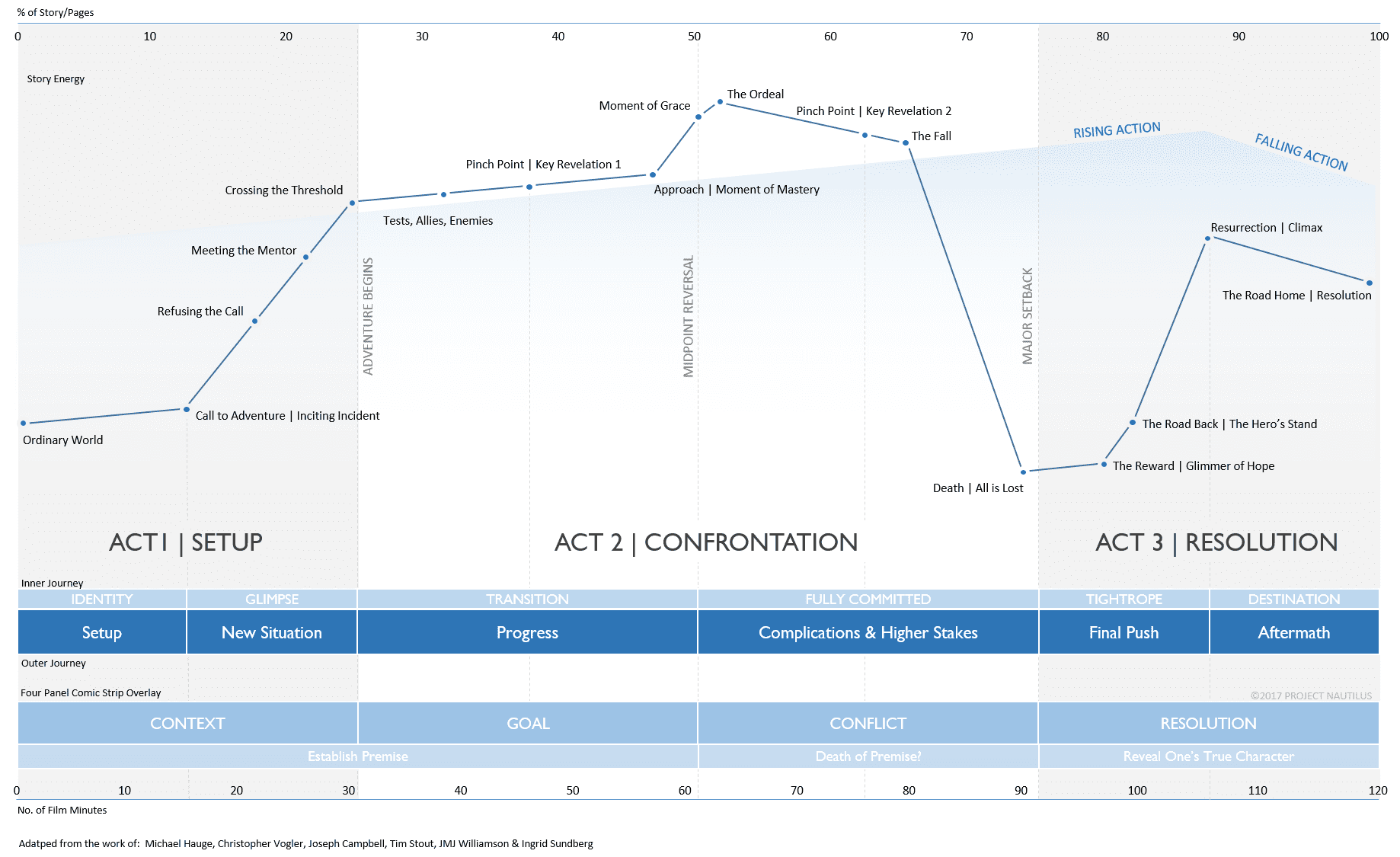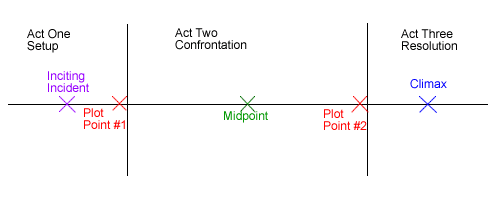The three-act structure is an ancient storytelling technique found in many stories and plays. It divides a story into thirds, or acts.
The three-act structure is a term that refers to the pattern of exposition, rising action, and climax in a story.
The three-act structure is a basic storytelling technique in which the plot of a story is divided into three parts, usually with an act break at the end of each part.
THREE ACT STRUCTURE
What Is Three Act Structure in Film?
In screenwriting, the three-act structure is a narrative framework that divides a story into three parts.
The first act sets up the protagonist’s problem and makes it clear they have to take action.
The second act shows how they fail at solving their problem as more obstacles arise.
But in the third act, our hero finally overcomes all odds and achieves their goal (or not).
In the world of screenwriting, the three-act structure is as fundamental as it gets.
It’s the backbone that supports nearly every successful movie we’ve seen.
We’ll jump into how this timeless framework can transform a good story into a great screenplay.
By the end, you’ll understand why mastering the three-act structure is a game-changer for any screenwriter.
What Is The Three-act Structure?
Understanding the three-act structure is essential for screenwriters who aim to craft compelling narratives.
It’s a model used in storytelling and screenwriting that divides a narrative into three parts – often termed the Setup, the Confrontation, and the Resolution.
In the first act, or the Setup, we introduce the audience to the setting, characters, and the central conflict.
Films like The Matrix expertly present the protagonist in their normal world before the inciting incident upends their life.
It’s crucial to establish the stakes early on to ensure viewers are invested in the character’s journey.
Moving into the second act, known as the Confrontation or the Rising Action, tension builds as the main character faces obstacles.
This is the longest section of the screenplay where subplots may flourish and where characters are often tested to their limits.
eventually, it leads to the second act’s climax, the moment of greatest conflict.
The third act, featuring the Resolution, brings closure.
It’s where storylines converge, and the protagonist’s arc reaches its culmination.
In films such as The Shawshank Redemption, this act delivers the payoff and often leaves a lasting impression on the audience.
Here are a few key points to keep in mind about each part of the structure:
- Act One: Setup – offers the introduction and inciting incident.
- Act Two: Confrontation – showcases challenges and character development.
- Act Three: Resolution – concludes the story and resolves the conflict.

When executed well, the three-act structure ensures a coherent and enthralling story that resonates with viewers.
It provides a blueprint that, when combined with robust character arcs and thematic significance, elevates a screenplay from good to unforgettable.
Act 1: Setup
The opening act of any screenplay is where we lay the groundwork for the story to come.
In Act 1 – the Setup – we’re responsible for drawing our audience into the world we’ve created.
Characters are introduced, often starting with our protagonist, and we establish the ordinary world they inhabit before the central conflict emerges.
We see examples of this in movies like The Matrix, where we meet Neo in his mundane reality, or in Toy Story, where we learn about Andy’s bedroom and the toys’ lives.
It’s essential that we set up the stakes and the goals for our characters.
What do they want?
What’s holding them back?
These are the questions we must answer to give the narrative its driving force.
Here are key elements to consider during the Setup:
- Introducing main and supporting characters – Establishing the setting – Unveiling the initial situation and central conflict,
- Presenting the protagonist’s goal.
Our primary task in this segment is to hook our audience with a compelling premise or a question that begs an answer.
This curiosity propels the story into the impending challenges of the second act.
As we transition from the comfort of the known world to the impending chaos of the conflict, we ensure the tone and genre are firmly set.
Whether it’s a comedy like Bridesmaids or a thriller like Inception, the tone is clear from the get-go.
Overall, Act 1 serves as a crucial foundation for the plot twists and character development to come.
Without a strong setup, the rest of the film may falter, no matter how well-crafted the subsequent acts are.
Act 2: Confrontation
After laying the groundwork in the Setup, we move into the heart of the story – Act 2.
This is typically the longest section of any screenplay and presents a series of escalating challenges our protagonist must face.
It’s where the tension builds, and stakes are elevated, demanding greater depth and complexity in character development.
In this phase, the initial conflict intensifies, often through the introduction of new obstacles or complications.
Subplots may arise, interacting with the main storyline to enrich the narrative tapestry.
Characters, including the antagonist, reveal more layers, their motivations and backstories adding to the central drama.
We witness the protagonist’s journey, where their resolve is tested to the extreme.
It’s not just about physical confrontations but also emotional and mental battles.
The heart of the narrative beats in scenes that pounce on our emotions, hooking us to the characters’ fates.
Key elements often at play during Act 2 include:
- Character Development – individuals are pushed beyond their limits,
- Plot Twists – events take unexpected turns, heightening intrigue,
- Rising Action – challenges grow, requiring proactive decisions.
The end of Act 2 marks a critical turn – the protagonist often faces their lowest point.
It’s a moment that seems insurmountable, triggering what we call the Dark Night of the Soul.
Here, our hero must harness growth from preceding trials to prepare for the coming climax.
This transformative period is vital as it sets up the Resolution.
Here, the inner and external arcs align, propelling our characters toward a convergence of the story’s threads.
The momentum from Act 2 fuels what must be a satisfying and resonant peak to the narrative arc.
Act 3: Resolution
Act 3 is where all the threads of the story are woven together.
This final act provides resolution to the central conflict and showcases how characters have changed and evolved from their experiences.
It’s in the Resolution where protagonists face their ultimate test.
Often mirroring a situation from Act 1, this final confrontation demonstrates how they’ve grown.
The structure of Act 3 typically follows a set path – the climax, the falling action, and the denouement.
Each segment is crucial in delivering a story that resonates with audiences.
– The climax is the highest point of tension and drama
- Falling action shows the results of the climax and begins to tie up loose ends,
- Denouement offers a glimpse into the aftermath and future of the characters.
Notable films such as The Godfather exemplify how a potent Act 3 can leave lasting impressions.
These final scenes often linger in the minds of viewers, making the journey memorable.
Key elements in Act 3 include: – Cathartic release of built-up tension
- Confirmation of themes and motifs presented in the film,
- Showing character transformations.
Crafting an effective Act 3 demands meticulous setup in the earlier acts.
It’s not just about providing endings but about offering a sense of completeness.
From our perspective, knowing that the structure serves not just to conclude but also to elevate the entire narrative is what sets apart great screenwriting.
The emphasis should be on crafting a resolution that feels both surprising and inevitable.
Action sequences, emotional reconciliations, and poignant farewells all find their place in Act 3.
They work together to satisfy the narrative promise made to viewers from the start.
Ensuring that the ending offers a reflection of the story’s larger message or theme can make the difference between a good film and a great one.
It’s these details that contribute to the film’s overall impact and audience’s satisfaction whilst they ride out the waves of the story’s climax.
How Does The Three-act Structure Enhance Storytelling?
When we jump into a story, the three-act structure serves as the backbone, guiding both the creators and the audience through the narrative journey.
It’s a tried-and-true framework that not only provides clarity but also ensures that the storytelling reaches its full potential.
By adhering to this structure, films such as The Shawshank Redemption have delivered compelling and cohesive narratives that resonate deeply with audiences.
The predictability of this structure might seem counterintuitive to creativity, yet it’s this very framework that liberates filmmakers.
We’re able to explore the narrative depths within the safety of a proven format – it’s the creativity between the pillars of each act that distinguishes each story.
For instance, Inception uses the three-act layout to ground its complex plot, allowing viewers to follow the labyrinthine story with ease.
Adopting the three-act structure allows us to:
- Manage pacing and tension – ensuring that the narrative has a rhythm that keeps the audience engaged.
- Develop characters effectively – using act transitions to showcase growth and change.
- Build to a satisfying climax – creating a peak moment that feels both inevitable and surprising.
By implementing this historic formula, we create a solid foundation upon which we can layer our unique twists and turns.
Movies like The Matrix and Star Wars have become iconic, in part, due to their masterful use of the three-act structure to craft engaging and memorable stories.
It’s clear that the three-act structure isn’t just about abiding by rules; it’s about creating a narrative harmony where our stories thrive.
We weave emotions, character arcs, and thematic resonance through this structure, ensuring that every element is in place for a storytelling experience that feels both familiar and fresh.
Whether we’re dealing with indie dramas or blockbuster spectacles, the three-act structure remains a powerful tool in our storytelling arsenal.
The Importance Of Proper Pacing
Pacing is the rhythmic flow of a screenplay and is crucial in engaging the audience.
Proper pacing ensures that the story unfolds at just the right tempo, maintaining viewers’ interest throughout.
In the three-act structure, each act has its pacing needs.
The first act sets up the story, the second act escalates the conflict, and the third act brings everything to a climax and resolution.
We need to balance these pacing requirements to create a cohesive narrative.
- Act 1 – Introduction and Setup,
- Act 2 – Confrontation and Development,
- Act 3 – Climax and Resolution.
Films like Inception expertly manipulate pacing, blending fast-paced action with slower, more emotional scenes.
This contrast in pacing enhances the overall impact of the film’s storytelling.
Effective pacing also allows for character development.
Audiences learn about characters gradually, as pacing dictates when to reveal their backstories, motivations, and changes.
By controlling the pacing, filmmakers keep the tension high and provide the necessary breathers.
It’s about knowing when to accelerate the action and when to slow things down, allowing for character and plot development.
For instance, The Dark Knight uses pacing as a tool to juxtapose the calm before the storm with the chaos of the Joker’s rampage.
These shifts in pacing heighten the audience’s emotional response and investment in the narrative.
Maintaining a firm grasp on pacing is vital for the momentum of the story.
We must carefully consider every scene and its contribution to the overall pacing of the film.
Balancing Character Development And Plot Progression
While understanding the beats of the three-act structure, it’s essential to balance character arcs with the forward momentum of the plot.
In the first act, we reveal our character’s world and set up the transformative journey they’re poised to embark on.
Alongside this personal exposition, we also ignite the story’s primary conflict, pulling the audience into the narrative and setting the stage for what’s to come.
Act two is a playground for character development – this is where our protagonist’s mettle is tested, often through struggles that push them to evolve.
These challenges are not random; they’re directly tied to the plot’s progression, ensuring that character growth and story advancement are two sides of the same coin.
To manage this delicate balance, consider:
- Ensuring each character’s decision impacts the plot,
- Using subplots to explore supporting characters.
By the time we reach act three, the interplay between character and plot reaches its zenith.
This is the act where the character’s arc culminates in decisive action, which in turn brings the plot to its climax.
For instance, The Godfather masterfully aligns Michael Corleone’s transformation with the overarching plot, a balancing act that elevates the narrative to new heights.
Keeping character development and plot interwoven throughout creates a cohesive story.
Viewers or readers are more likely to stay engaged if they can see their favorite characters grow and change in ways that are integral to the unfolding story.
Films like Lord of the Rings or The Matrix showcase characters whose personal journeys are crucial to the progression of the plot and the resolution of the central conflict.
We weave these journeys like threads in a tapestry, creating a narrative that resonates at both an emotional and a structural level.
By addressing both aspects in each act, we create a story that feels robust and layered.
The aim is for every moment of character development to feel essential, propelling the plot forward rather than detracting from it.
When character and plot advance in harmony, the story organically builds to a satisfying climax, ensuring the audience remains hooked until the very end.
Creating Tension And Conflict
In screenwriting, tension and conflict are the engines that drive the narrative forward.
Conflict arises not just from the clash of character goals but from the internal struggles within each character.
We understand that without these elements, our screenplay risks falling flat, leaving audiences disengaged.
We employ various techniques to escalate conflict in each act.
In the first act, our story’s world is established along with the protagonist’s routine.
Suddenly, an inciting incident shatters the status quo, posing an immediate question and spurring the need for resolution.
The second act is where we ramp up the tension.
Characters are faced with complications that test their resolve:
- Compelling dilemmas – choices that challenge a character’s values – Rising stakes – each decision must have significant consequences – Plot twists – unexpected turns that keep the story unpredictable.
By threading these elements through our narrative, we ensure that each scene builds upon the last.
The third act is where the highest point of tension resides – the climax.
Here, our characters are pushed to their limits, and the outcome of their journeys is at stake.
The resolution of these conflicts doesn’t just provide spectacle but also drives character development.
In films like The Godfather, viewers are captivated by Michael Corleone’s descent into darkness – a direct result of the tensions he faces.
To maintain tension, we’re mindful of pacing.
Rapid-fire sequences interspersed with moments of calm keep audiences on the edge of their seats.
These peaks and valleys in the story’s rhythm are intentional, crafted to evoke a range of emotions from the viewer.
As we weave conflict through our scripts, we understand that it’s not merely about confrontation.
It’s the uncertainty, the choices, the potential for loss or triumph.
And it’s these components that transform the tale we tell into an experience the audience won’t forget.
Tips For Effectively Using The Three-act Structure In Screenwriting
Establishing the Foundation in Act One is crucial for setting the stage.
It’s imperative to introduce your protagonist and their world while presenting the inciting incident that propels them into conflict.
Our goal here is to hook the audience with a compelling setup that promises an intriguing journey ahead.
The Second Act should be the proving ground for our characters.
As screenwriters, we must challenge our protagonists with obstacles that are increasingly difficult, forcing them to evolve.
This act is the heart of the story, where the main plot thrives and subplots add complexity, ensuring that our audience remains riveted.
Navigating Through Act Two also involves balancing the character’s inner journey with external struggles.
We consider this synergy critical – it’s what keeps viewers emotionally invested.
- The protagonist’s personal growth,
- The external pressures they face.
These elements must intertwine seamlessly, making every action count towards the impending climax.
Crafting the Climax in Act Three requires finesse.
Everything that’s been set up needs to come together in a satisfying, yet surprising way.
This can often be where the true theme of the story is fully realized, sending a resounding message that resonates with the audience.
To Maintain Momentum, screenwriters should use the following techniques:
- Foreshadowing events,
- Planting and paying off,
- Keeping dialogue and scenes concise.
These strategies help the plot move forward without losing steam, ensuring that the final act hits its mark with maximum impact.
Developing the Resolution without creating a lull in the story’s pace is another delicate aspect we must master.
It should tie up loose ends without feeling rushed or leaving critical questions unanswered.
Our viewers need to depart with a sense of closure that rewards their emotional investment.
finally, We Must Craft Each Scene with Purpose.
Every moment in our screenplay should serve the larger narrative.
It’s our responsibility to be ruthless editors, cutting scenes that don’t move the story forward, But much we may love them.
Such discipline results in a tight, engaging script that makes every line, every action, count.
Using Three Act Structure In Screenwriting – Wrap Up
We’ve explored the intricate dance between character arcs and plot within the three-act structure, underscoring its pivotal role in screenwriting.
Mastering this framework allows us to craft stories that resonate deeply with audiences.
By laying a solid foundation in the first act, threading character development seamlessly through the second, and delivering a satisfying climax in the third, we create narratives that are both compelling and memorable.
Let’s harness these insights to elevate our screenwriting, ensuring every scene serves a purpose and our editing is sharp.
With these strategies in hand, we’re well-equipped to captivate viewers from the opening scene to the final credits.
Frequently Asked Questions
What Is The Three-act Structure In Screenwriting?
The three-act structure is a model used in screenwriting that divides the narrative into three parts: Act One sets up the character’s world and conflict; Act Two focuses on character development through challenges related to the plot; and Act Three culminates in a climax resolving the conflict.
How Does The Three-act Structure Balance Character And Plot?
The three-act structure balances character and plot by intertwining the protagonist’s personal growth with the forward momentum of the story.
Each act provides a framework for the character’s decisions and evolution to be directly influenced by the unfolding events.
What Should The First Act Establish In A Screenplay?
The first act should establish the protagonist’s world, their status quo, and the primary conflict that disrupts their life.
This foundation sets up the narrative and stakes that will drive the rest of the story.
How Does The Second Act Contribute To Character Development?
The second act presents obstacles and challenges that test the protagonist, prompting personal growth and development.
This act delves deeper into the character’s journey, revealing their fears, desires, and the transformative process they undergo.
What Happens In The Third Act Of The Three-act Structure?
In the third act, the protagonist’s character arc reaches its peak as they take decisive action.
This act brings about the story’s climax and resolution, ultimately resolving the central conflict introduced in the first act.
How Can A Writer Maintain Momentum In Their Screenplay?
A writer can maintain momentum by using techniques such as foreshadowing, crafting concise dialogue, and ensuring each scene has a distinct purpose that drives the plot forward and keeps the audience engaged.
What Role Does Editing Play In Crafting A Screenplay?
Editing plays a crucial role in crafting an engaging screenplay.
Being a ruthless editor means cutting out unnecessary scenes, refining dialogue, and ensuring that the script is tight and focused, which helps to maintain pace and keeps audiences invested in the story.



Matt Crawford
Related posts
16 Comments
Leave a Reply Cancel reply
This site uses Akismet to reduce spam. Learn how your comment data is processed.







This is a great guide! I’ve been trying to learn more about three act structure and this is a great resource.
Thanks, Pat.
This is a great guide! I’ve been trying to learn more about three act structure and this is a great resource.
Thanks, Greg.
Awesome guide! I too myself have common troubles with second act. I lack of pacing
Thanks, Travis, appreciate it. Hopefully you find some tips around our site.
This blog post is incredibly informative and well-structured. As a beginner filmmaker, I find the breakdown of the three act structure especially helpful in understanding the overall structure of a film. The examples provided are also great in illustrating how the structure can be applied to different types of movies. Thank you for sharing your knowledge!
Appreciate the comment
Great breakdown of the three act structure in film! As a film enthusiast, I find it fascinating how this structure has been used in so many classic movies. The examples you provided were particularly helpful in illustrating how the different acts work together to create a compelling narrative. Thanks for sharing your insights!
Great comment! Do you have any experiences to share on this?
Wow, this was really informative! I’ve always struggled to understand the three-act structure in film, but your examples really helped clarify it for me. The way you broke down the acts and provided specific movie examples was super helpful. I’ve realized now that I’ve been seeing this structure in movies my whole life without realizing it!
Interesting take! Appreciate the input.
Just wanted to say thank you for this comprehensive guide to the three-act structure! I’ve been looking for a simple and clear explanation of how to apply it to film, and this post hit the spot. The examples from popular movies really helped to make the concepts more tangible. I’m looking forward to applying this structure to my own screenwriting projects!
Would love to hear more of your thoughts—thanks for chiming in!
Loved this breakdown of the three-act structure! I knew it existed but never really understood how to apply it, but these examples really helped clarify things for me. Can’t wait to see if I can spot it in my favorite films now
Appreciate it! Hope you’re having an awesome day.